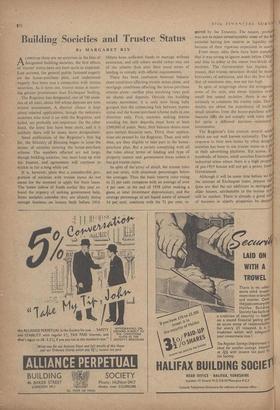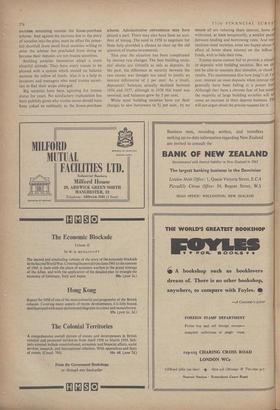Building Societies and Trustee Status
By MARGARET RIX
ALTHOUGH there are no surprises in the lists of designated building societies, the first effects of 'trustee' status have not been quite as expected. Last autumn, the general public fastened eagerly on the house-purchase plan, and understood vaguely that there was a connection with trustee securities. As it turns out, trustee status is receiv- ing greater prominence than Exchequer lending.
The Registrar has designated, out of 740 socie- ties of all sizes, about 160 whose deposits are now trustee investments. A discreet silence is kept about rejected applications, though the unknown numbers who tried it on with the Registrar, and failed, are probably not important. On the other hand, the latest lists have been short, and it is unlikely there will be many more designations.
Since publication of the Registrar's first big list, the Ministry of Housing began to issue the names of societies entering the house-purchase scheme. The numbers affected are not large. though building societies, too, must keep up with the Joneses, and agreements will continue to trickle in for a long while yet.
It is, however, plain that a considerable pro- portion of societies with trustee status do not mean for the moment to apply for State loans. The better inflow of funds earlier this year re- laxed the urgency of seeking government help. Some societies consider they are already doing enough business on houses built before 1919. Others have sufficient funds to manage without assistance, and still others would rather stay out of the scheme than alter their usual terms of lending to comply with Official requirements.
There has been confusion between balance sheet conditions affecting trustee status alone, and mortgage conditions affecting the house-purchase scheme alone—neither plan involving rates paid on shares and deposits. Outside the building society movement, it is only now being fully grasped that the connecting link between trustee status and the house-purchase scheme pulls in one direction only. First, societies seeking trustee standing for their deposits must have at least £500,000 of assets. Next, their balance sheets must pass certain financial tests. Third, their applica- tions are pruned by the Registrar. Then, and only then, are they eligible to take part in the house- purchase plan. But a society complying with all the rules about terms of lending and type of property cannot seek government loans unless it has got trustee status.
In spite of the array of detail, the trustee rules are not strict, with minimum percentages below the averages. Thus the basic reserve ratio rising to 24 per cent. compares with an average of over 4 per cent, at the end of 1958 (after making a guess at total investment depreciation), and the average percentage of net liquid assets of around 14 per cent. contrasts with the 71 per cent. re- quired by the Treasury. The reason, proba' was not to reject unwarrantably some of the 12 societies having low reserve or liquidity rat because of their vigorous expansion in assets.
From many sides there have been complal that it was wrong to ignore assets below £500. and thus to debar at the outset two-thirds of societies. The Government has replied. 'A reason, that trustee securities should be those borrowers of substance, and that the first his that of minimum size, was not too high.
In spite of' misgivings about the stringencY some of the tests, and about injustice tows' small but sound societies, there is no ca seriously to condemn the trustee rules. Our doubts are about the expediency of exclud small societies from the house-purchase schc, because they do not comply with rules dev1 for quite a different purnose—suitability investments.
The Registrar's lists contain several soeie which are not well known nationally. The cln response to their new status by other design& societies has been to use trustee status as a 1313 in their advertising platform. Yet scores, if hundreds, of honest, small societies functioning industrial areas where there is a high proporti of pre-1919 houses will not get a penny front Government.
Although it will be some time before we VI'
the amount of Exchequer loans, present it'd bons are that the net additions to mortgages older houses, attributable to the trustee sYst will be modest. There is already a good vol of business in elderly properties by designs
societies remaining outside the house-purchase scheme. And against the increase due to the entry of societies into the plan, must be offset the poten- tial shortfall from small local societies willing to enter the scheme but precluded from doing so because their deposits are not trustee securities.
Building societies themselves adopt a more cheerful attitude. They have every reason to be pleased with a system which should on balance increase the inflow of funds. Also it is a help to investors and managers who need trustee securi- ties to find their scope enlarged.
Big societies have been agitating for trustee status for years. No satisfactory explanation has been publicly given why trustee status should have been yoked so ruthlessly to the house-purchase
scheme. Administrative convenience may have played a part. There may also have been an acci- dent of timing. The need in 1958 to negotiate for State help provided a chance to clear up the old question of trustee investments.
This year the situation has been complicated by interest rate changes. The best building socie- ties' shares are virtually as safe as deposits. In the past, the difference in security between the two classes was thought too small to justify an interest differential of + per cent. As a result, depositors' balances actually declined between 1954 and 1957, although in 1958 this trend was reversed, and balances grew by 5 per cent.
While most building societies have cut their charges to new borrowers to 5+ per cent., by no
means all are reducing share interest. Sonic withstand, at least temporarily, a smaller cnari between lending and borrowing rates. And ma medium-sized societies, none too happy ,about effect of lower share interest on the inflow funds, wish to bide their time.
Trustee status cannot fail to provide a stinuf to deposits with building societies. But we sll not be able to measure that stimulus, or check results. The maintenance (for how long?) of 3 I cent. interest on most deposits when interest ra generally have been falling is a potent for Although they have a chronic fear of hot mon
e!
the majority of large building societies will come an increase in their deposit business. Tl will not argue about the precise reasons for it.
a















































 Previous page
Previous page